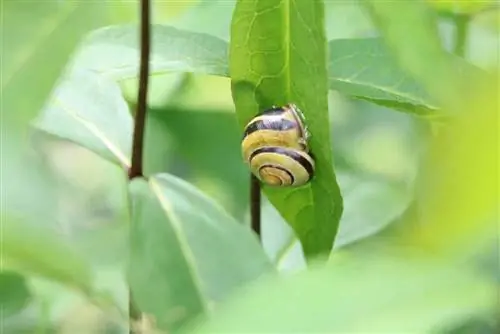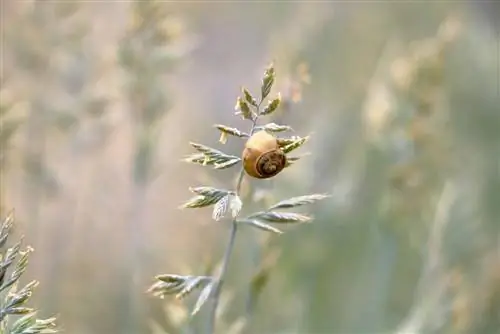- Author admin [email protected].
- Public 2023-12-17 03:39.
- Last modified 2025-01-24 12:45.
When it comes to snails in the garden, you have to get to the root of the problem. In concrete terms, this means that the animals' eggs should be radically destroyed if possible. This can reliably prevent an epidemic spread of the plague. The problem is that you first have to find the eggs and recognize them. In addition, preventive measures are crucial.
Basic
A snail plague in the garden usually starts with just a few animals. Although these can certainly cause damage to fruit and vegetable plants, in most cases they can still be overcome if necessary. However, it becomes problematic when the snails multiply explosively. This does not happen through immigration, but through mating and egg laying. So it is the young snails that ultimately become a danger to the garden.
To make this clear: A single Spanish slug, the most common slug species in our gardens, produces and lays between 200 and a maximum of 500 eggs per year. If even ten percent of new snails develop from these eggs, you have a problem - especially because there is usually more than one adult snail in every garden.
Egg laying
The Spanish slug and other snail species are hermaphrodites, but they still need a partner for mating in order to be able to produce offspring. This mating normally occurs in late summer or early fall. Immediately afterwards, the animals begin laying eggs. As a rule of thumb, you can expect this from the end of August. A snail does not lay all the eggs it carries in one place, but rather distributes them across a whole series of places. There are usually around 50 eggs per clutch. With 200 to 400 eggs per animal, you can easily assume four to eight clutches, which can be spread across the entire garden. Therefore, the first step is to search to find them.
Places
Luckily, a snail doesn't lay its eggs randomly. Rather, the respective locations must meet certain requirements. Above all, they must be protected, relatively cool and moist. This limits the options somewhat and makes it easier to specifically search for the eggs. You can often find what you are looking for in these places or places:
- small holes in the ground
- under stones of every size
- under troughs, plant pots and buckets
- in the passages that produced earthworms
- in the compost heap
- among mosses of all kinds
- in heaps of leaves
- under applied bark mulch
If you want to find snail eggs in your garden, you can't avoid turning over practically every stone. This takes effort and takes time. But it's worth it because every egg discovered and destroyed also means that you'll definitely have one less snail in your garden next season. By the way, the adults usually die shortly after laying their eggs.
Recognize

Snail eggs are usually white or slightly transparent, spherical in shape and about the size of a pinhead. Recognizing a single egg in the garden is almost possible. However, a complete clutch of around 50 eggs can definitely be found. The eggs lie very close together in a loose bond. From a distance it often looks like a single, misshapen white lump. However, they are not clumped together. They also do not have a jelly-like mass. The clutch may be more reminiscent of a collection of smaller berries that are loosely placed close together as if by chance.
Destroy
It is often enough to remove the protection from the eggs to destroy them. If you remove the stone or the pot under which they lie, they are not only exposed to sunlight, but can also be found and eaten by natural predators. While the adult Spanish slug is despised by hedgehogs and birds because of its bitter mucus, the snail eggs are a real delicacy for the animals. Of course, this especially applies to ducks in the garden, which also eat the adult snails and specifically track down their eggs. However, if you don't want to rely on predators, collect the eggs in a glass or can and then expose them to the midday sun. The result is that the eggs dry out and die. Alternatively, they can also be burned.
Note:
Snail eggs must under no circumstances be thrown into the compost, as this would encourage development.
Prevention
Prevention is known to be better than cure. This also applies to snail control. Consequently, everything should be done to make the garden as unattractive as possible for animals. Above all, care should be taken to ensure that there are as few places as possible where the snails could lay their eggs. Piles of leaves and grass are therefore just as taboo as stones or plant troughs. The latter should definitely be reduced if possible. Holes that appear when carrots or kohlrabi are pulled out must be filled again immediately. In general, it is recommended to hook the beds thoroughly after harvesting and then smooth them out with the back of the rake so that a smooth surface is created. The best preventative measure is undoubtedly running ducks, which roam freely in the garden - and which you can now rent by the day or by the hour.

